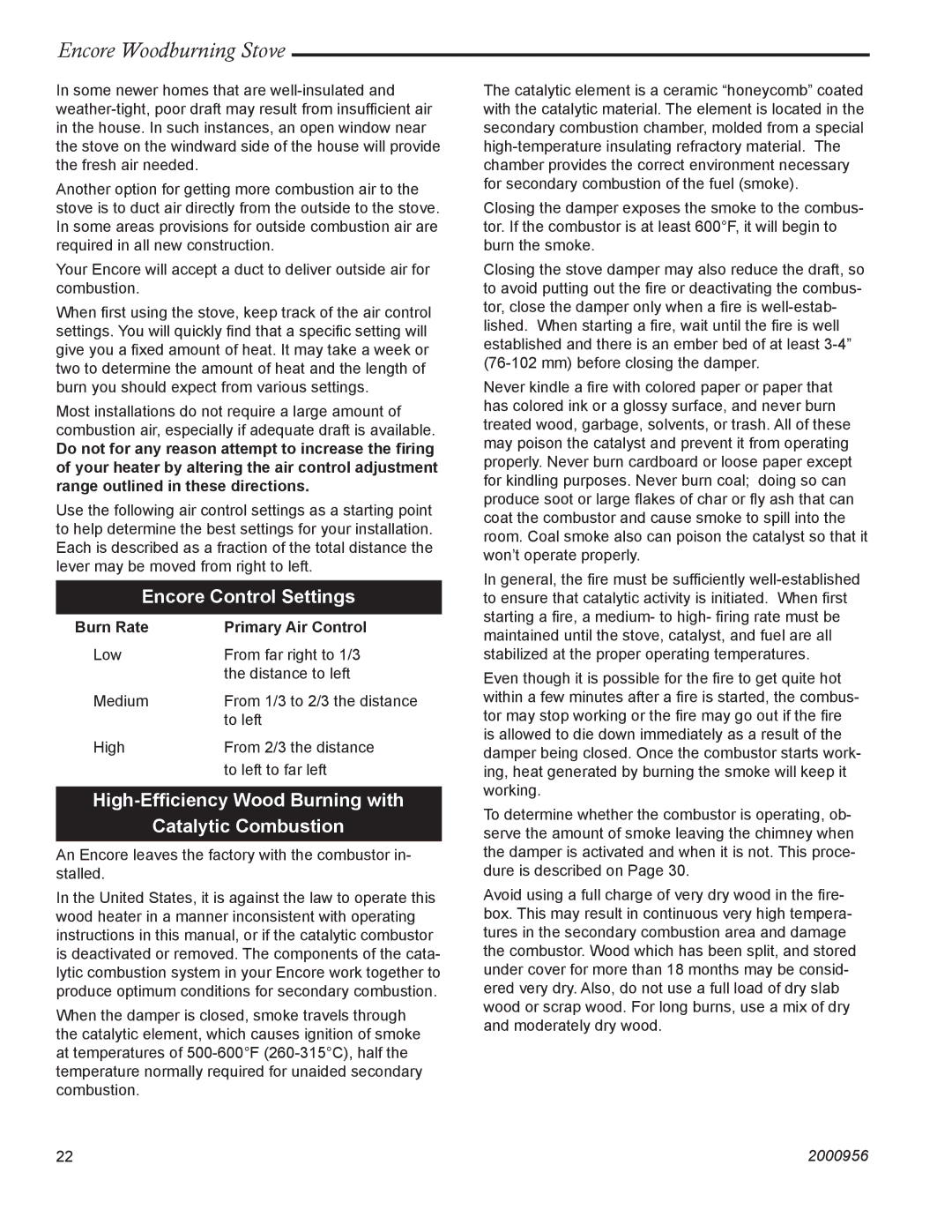
Encore Woodburning Stove
In some newer homes that are
Another option for getting more combustion air to the stove is to duct air directly from the outside to the stove. In some areas provisions for outside combustion air are required in all new construction.
Your Encore will accept a duct to deliver outside air for combustion.
When first using the stove, keep track of the air control settings. You will quickly find that a specific setting will give you a fixed amount of heat. It may take a week or two to determine the amount of heat and the length of burn you should expect from various settings.
Most installations do not require a large amount of combustion air, especially if adequate draft is available.
Do not for any reason attempt to increase the firing of your heater by altering the air control adjustment range outlined in these directions.
Use the following air control settings as a starting point to help determine the best settings for your installation. Each is described as a fraction of the total distance the lever may be moved from right to left.
Encore Control Settings
Burn Rate | Primary Air Control |
Low | From far right to 1/3 |
| the distance to left |
Medium | From 1/3 to 2/3 the distance |
| to left |
High | From 2/3 the distance |
| to left to far left |
High-Efficiency Wood Burning with
Catalytic Combustion
An Encore leaves the factory with the combustor in- stalled.
In the United States, it is against the law to operate this wood heater in a manner inconsistent with operating instructions in this manual, or if the catalytic combustor is deactivated or removed. The components of the cata- lytic combustion system in your Encore work together to produce optimum conditions for secondary combustion.
When the damper is closed, smoke travels through the catalytic element, which causes ignition of smoke at temperatures of
The catalytic element is a ceramic “honeycomb” coated with the catalytic material. The element is located in the secondary combustion chamber, molded from a special
Closing the damper exposes the smoke to the combus- tor. If the combustor is at least 600°F, it will begin to burn the smoke.
Closing the stove damper may also reduce the draft, so to avoid putting out the fire or deactivating the combus- tor, close the damper only when a fire is
Never kindle a fire with colored paper or paper that has colored ink or a glossy surface, and never burn treated wood, garbage, solvents, or trash. All of these may poison the catalyst and prevent it from operating properly. Never burn cardboard or loose paper except for kindling purposes. Never burn coal; doing so can produce soot or large flakes of char or fly ash that can coat the combustor and cause smoke to spill into the room. Coal smoke also can poison the catalyst so that it won’t operate properly.
In general, the fire must be sufficiently
Even though it is possible for the fire to get quite hot within a few minutes after a fire is started, the combus- tor may stop working or the fire may go out if the fire is allowed to die down immediately as a result of the damper being closed. Once the combustor starts work- ing, heat generated by burning the smoke will keep it working.
To determine whether the combustor is operating, ob- serve the amount of smoke leaving the chimney when the damper is activated and when it is not. This proce- dure is described on Page 30.
Avoid using a full charge of very dry wood in the fire- box. This may result in continuous very high tempera- tures in the secondary combustion area and damage the combustor. Wood which has been split, and stored under cover for more than 18 months may be consid- ered very dry. Also, do not use a full load of dry slab wood or scrap wood. For long burns, use a mix of dry and moderately dry wood.
22 | 2000956 |
